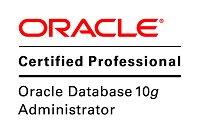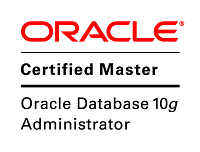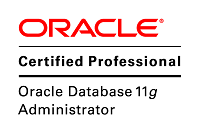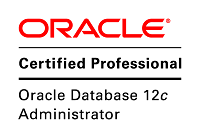Exadata X5的新特性,很有意思,软硬件都有很多改变,个人感觉最突出的硬件改变是X5只有两种磁盘配置:
1,全闪配置(EF)
2,SSD(Flash F160 NVMe PCIe card with 1.6 TB)+4T(HC DISK)
然后就是内存增加,CPU升级等等。。。
下面的信息来源于强大的MOS:
Oracle Exadata Database Machine X5-2 Support
……New Exadata X5-2 Database Server
.
Exadata X5-2 updates the 2-socket database servers to use the latest and fastest Intel Xeon E5-2699 v3 “Haswell” processors with 18 cores (vs. 12 cores in X4-2) for 50% greater performance. An X5-2 database server uses the faster DDR4 memory, and the default 256 GB configuration can now be expanded up to 768 GB, a 50% increase over the X4-2 maximum. The HBAs no longer depend on batteries to retain cached data, hence eliminating the need for preventive maintenance.
.
……New Exadata X5-2 High Capacity (HC) Storage Server
Exadata X5-2 updates the 2-socket storage server to an eight-core (33% increase) Intel Xeon E5-2630 v2 processor and the flash card to the Sun Accelerator Flash F160 NVMe PCIe card with 1.6 TB (100% increase). The HBAs in the storage servers also no longer use batteries which eliminates the need for planned maintenance. The disk drives remain at 4 TB, for a total of 48 TB per High Capacity Storage Server.
.
……Introducing Exadata X5-2 Extreme Flash (EF) Storage Server
Exadata X5-2 replaces the X4-2 High Performance Storage Server with an all PCI flash based storage server. Each Extreme Flash storage server has eight 1.6 TB NVMe PCIe flash drives, with a total raw capacity of 12.8 TB. Extreme Flash storage delivers consistently low latency and the highest levels of performance for scans and OLTP read/write IOPS. The Extreme Flash storage server uses the same eight-core Intel Xeon processor as the High Capacity Storage Server.
.
Oracle Exadata Database Machine Elastic Configurations
.
Elastic configurations allow Oracle Exadata Racks to have customer-defined combinations of database servers and Exadata Storage Servers. This allows the hardware configuration to be tailored to specific workloads such as Database In-Memory, OLTP, Data Warehousing, or Data Retention.
.
Sparse Grid Disks
.
Sparse grid disks allocate space as new data is written to the disk, and therefore have a virtual size that can be much larger than the actual physical size. Sparse grid disks can be used to create a sparse disk group to store database files that will use a small portion of their allocated space.
.
Snapshot Databases for Test and Development
.
Space efficient database snapshots can now be quickly created for test and development purposes. Snapshots start with a shared read-only copy of the production database (or pluggable database (PDB)) that has been cleansed of any sensitive information. As changes are made, each snapshot writes the changed blocks to a sparse disk group.
.
Columnar Flash Caching
Oracle Exadata Storage Server Software release 12.1.2.1.0 can efficiently support mixed workloads, delivering optimal performance for both OLTP and analytics. This is possible due to the dual format architecture of Smart Flash Cache that enables the data to be stored in hybrid columnar for transactional processing and pure columnar optimized for analytical processing.
Oracle Exadata Storage Server Software I/O Latency Capping for Write Operations
.
Oracle Exadata Storage Server Software automatically redirects high latency write I/O operations to another healthy flash device on the same cell. After the write is successfully completed on another healthy flash device, the write I/O is acknowledged as successful to the database thereby eliminating the write outlier. This feature requires write back flash cache to be enabled on the cell.
.
Elimination of False Drive Failures
.
In the event of an apparent hard drive failure on X5-2 High Capacity cell or an apparent flash drive failure on X5-2 Extreme Flash cell, Oracle Exadata Storage Server Software automatically redirects I/Os to other drives, and then power cycles the drive. If the drive returns to normal status after the power cycle, then it will be re-enabled and resynchronized. If the drive continues to fail after being power cycled, then it will be dropped. This feature allows Oracle Exadata Storage Server Software to eliminate false-positive disk failures and therefore helps to preserve data redundancy and reduce management.
.
Flash and Disk Life Cycle Management Alert
.
Oracle Exadata Storage Server Software now monitors Oracle ASM rebalance operations due to disk failure and replacement. Management Server sends an alert when a rebalance operation completes successfully, or encounters an error.
.
Performance Optimization for SQL Queries with Minimum or Maximum Functions
.
SQL queries using minimum or maximum functions are designed to take advantage of the storage index column summary that is cached in Exadata Storage Server memory. As a query is processed, a running minimum an a maximum value is tracked. Before issuing an I/O, the minimum/maximum value cached in the storage index for the data region is checked in conjunction with the running minimum/maximum value to decide whether that I/O should be issued or can be pruned. Overall, this optimization can result in significant I/O pruning during the course of a query and improves query performance.
.
Oracle Exadata Storage Server Software Performance Statistics in AWR Reports
.
Exadata Storage Server configuration and performance statistics are collected in an Automatic Workload Repository (AWR) report. The AWR report provides storage level performance statistics, not restricted to a specific instance or a database. This is useful for analyzing cases where one database can affect the performance of another database.
.
Exafusion Direct-to-Wire Protocol
.
Exafusion Direct-to-Wire protocol allows database processes to read and send Oracle Real Applications Cluster (Oracle RAC) messages directly over the Infiniband network bypassing the overhead of entering the OS kernel, and running the normal networking software stack. This improves the response time and scalability of the Oracle RAC environment on Oracle Exadata Database Machine.
.
Management Server on Database Servers
.
Oracle Exadata Database Machine Command-Line Interface (DBMCLI) utility is the command-line administration tool for managing the database servers. DBMCLI runs on each server to enable you to manage an individual database server.
SQL Operators for JSON and XML
Oracle Exadata Storage Server Software supports offload of many SQL operators for predicate evaluation.
.
I/O Resource Management for Flash
.
I/O Resource Management (IORM) now manages flash drive I/Os in addition to disk drive I/Os to control I/O contention between databases, pluggable databases, and consumer groups. Since it is very rare for Oracle Exadata environments to be limited by OLTP I/Os, IORM automatically prioritizes OLTP flash I/Os over smart scan flash I/Os, ensuring fast OLTP response times with little cost to smart scan throughput.
.
Flash Cache Space Resource Management
.
Flash Cache Space Resource Management allows users to specify the minimum and maximum sizes a database can use in the flash cache using interdatabase IORM plans. Flash Cache Space Resource Management also allows users to specify the minimum and maximum sizes a pluggable database can use in the flash cache using database resource plans.
.
I/O Resource Management Profiles
.
IORM interdatabase plans now support profiles that reduce management of interdatabase plans for environments with many databases.
.
Write Back Flash Cache on Extreme Flash Cells
.
On Extreme Flash cells, flash cache runs in write back mode by default, and takes 5 percent of the flash space. It is useful for columnar caching, write I/O latency capping and fast data file creation.
Secure Erase for 1.6 TB Flash Drives in Extreme Flash and High Capacity Systems
Oracle Exadata Storage Server Software supports secure erase for 1.6 TB flash drives in the Extreme Flash and High Capacity systems. The 1.6 TB flash drives take approximately 5.5 hours to securely erase.
.
Increased Exadata Cell Connection Limit
.
Oracle Exadata X5-2 and X4-2 cells can now support up to 120,000 simultaneous connections originating from one or more database servers that is using active-active bonding. This implies that at most 120,000 processes can simultaneously remain connected to a cell and perform I/O operations.
.
Support for SNMP v3
.
Oracle Exadata Database Machine database and storage servers support SNMP v3 for sending alerts. SNMP v3 provides authentication and encryption for alerts sent from the servers to administrators and Auto Service Request.
.
Federal Information Processing Standards (FIPS) 140-2 Compliant Smart Scan
.
The U.S. Federal Information Processing Standard (FIPS) 140-2 specifies security requirements for cryptographic modules. To support customers with FIPS 140-2 requirements, Oracle Exadata version 12.1.2.1.0 can be configured to use FIPS 140-2 validated cryptographic modules. These modules provide cryptographic services such as Oracle Database password hashing and verification, network encryption (SSL/TLS and native encryption), as well as data at rest encryption (Transparent Data Encryption).
.
Oracle Exadata Virtual Machines
.
Consolidated environments can now use Oracle Virtual Machine (OVM) on X5-2, X4-2, X3-2, and X2-2 database servers to deliver higher levels of isolation between workloads. Virtual machine isolation is desirable for workloads that cannot be trusted to restrict their security, cpu, or memory usage in a shared environment.
.
Notable firmware updates
.
Aura 2.0 flash package update to 09.05.42.00 in X4270-M3 (X3-2L) storage servers.
Aura 2.1 flash package update to 09.05.43.00 in X4-2L storage servers.
ILOM update to 3.2.4.18 r93492 for X4-8 (X4-8) database servers
ILOM update to 3.0.16.20.g r93325 for X4800-M2 (X3-8) database servers.
ILOM update to 3.0.16.16.e r93323 for X4800 (X2-8) database servers.
ILOM update to 3.2.4.20.a r94217 for X4-2 (X4-2) database servers.
ILOM update to 3.2.4.22.a r94470 for X4-2L (X4-2L) storage servers.
ILOM update to 3.1.2.42.a r93409 for X4170-M3 (X3-2) database servers.
ILOM update to 3.1.2.44.a r93411 for X4270-M3 (X3-2L) storage servers.
ILOM update to 3.1.2.20.e r93424 for X4170-M2 (X2) database servers and X4270-M2 (X2) storage servers.
ILOM update to 3.0.16.15.h r93405 for X4170 (V2) database servers and X4275 (V2) storage servers.
Software Release Requirements
.
Exadata Storage Server Software 12.1.2.1.0 supports the following Oracle Database software releases:
.
Oracle Database 12c Release 1 (12.1.0.2.0)
Oracle Database 12c Release 1 (12.1.0.1.0)
Oracle Database 11g Release 2 (11.2.0.4.0)
Oracle Database 11g Release 2 (11.2.0.3.0) BP 20 or Newer BP
Oracle Enterprise Manager requires Exadata Plug-in version 12.1.0.5.0 or later to manage Exadata Storage Server Software 12.1.1.1.0.
Oracle Enterprise Manager requires Exadata Plug-in version 12.1.0.6.0 or later to manage Exadata Storage Server Software 12.1.2.1.0.
.






